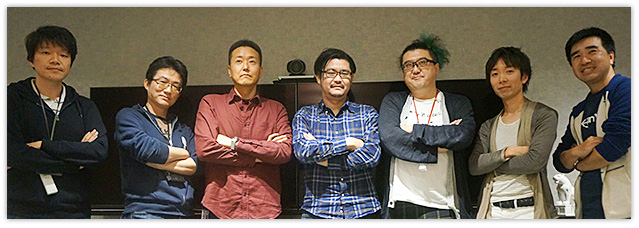
In the second part of our development episode, we pick up from where we left off in the Making of THE IDOLM@ASTER MILLION LIVE! THEATER DAYS (Part 1) and continue to showcase behind-the-scenes stories from the development of THE IDOLM@STER MILLION LIVE! THEATER DAYS (hereafter “MLTD”).
In this part, we talk with the game’s creators about anecdotes from development and the care that they put into creating characters with charming personalities.
THE IDOLM@STER MILLION LIVE! THEATER DAYS Project Team
| Takahiro Kakizawa | Game Designer/MLTD Planning Development Producer |
|---|---|
| Kentaro Tsuchihama | Game Designer/MLTD Planning Development Director |
| Kiyotaka Tamiya | Designer/MLTD Art Director |
| Hayato Ikeda | Program Engineer/MLTD Client Program Leader |
| Takafumi Sato | Sound Designer Composer/MLTD Sound Director |
| Yoshito Higashi | Game Designer/MLTD Content Director, Script Supervisor |
| Kenichiro Kubo | Game Designer/MLTD Live Show Director |
The Importance of Communication with Fans in Creating a Series that Continues to Evolve
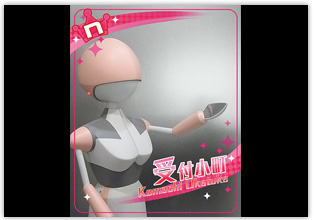
■Uketuke-Komachi
■Komachi: You mentioned that when developing MLTD, you tried to take advantage of the lightweight nature of the LiveOps format while also paying special attention to communication.
●Tsuchihama: We don’t believe that there is such thing as perfection for any LiveOps title, and this is especially the case with MLTD.
We try to avoid deciding things like how the application should look like one year from now. I think making decisions like that would mean that we aren’t doing our job exchanging opinions with the game’s fans.
We do try to add things that we think would improve the game as often as we can. However, we also make a point of listening to players’ opinions, and looking for things that fans of the game would want to try out or worlds they would want to experience. And my stance is, even if we come across ideas that stray from our plans, if they actually fit the current game better, then it’s a good thing! As a fan of the game who enjoys watching it change as I play, I think that we should set goals that make the game the best it can be.
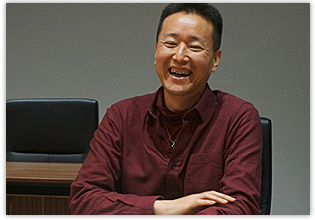
●Takahiro Kakizawa
Game Designer/MLTD Planning Development Producer
●Kakizawa: The current market for smartphone games has a very diverse user base, and now is a better time than ever to introduce MLTD to new fans. As creators, we’re very grateful to have our game available to such a wide variety of people.
With this in mind, we design MLTD to be enjoyable for both existing and new fans alike. We do our best to avoid letting down original fans, and try to fulfill their expectations while simultaneously remaking the brand for new users. We keep a close eye on the entire fan base to supply existing needs, but also make a point of appealing to unrealized demand. Usually that means updating parts of the games that aren’t on players’ radars, but when they play the game they realize they actually wanted all along.
●Tsuchihama: We actually made a Rehearsal Mode to practice the rhythm game in the live part. Then we were told, “This is practice, the idols should be wearing sweats!” (Points at Kubo.) And we said, “You’re right!” It’s exciting to hear these kinds of suggestions. And fans responded to it well. We saw comments saying “Look, they’re in sweats! It’s so cool that we get to see a different side of the idols!” I think we have a good setup, where everyone is able to come up with their own ideas to make the game better, and suggest them to other team members whenever they get the chance.
●Higashi: I think that showing all the practice and hardship that the idols endure off-stage gives a strong narrative to the game. The contrast between the glamour of the stage and the idols’ daily lives really makes the performances that much more dazzling.
■Komachi: I hear that Communication mode tells the idols’ story in its entirety until the point that they perform on stage.
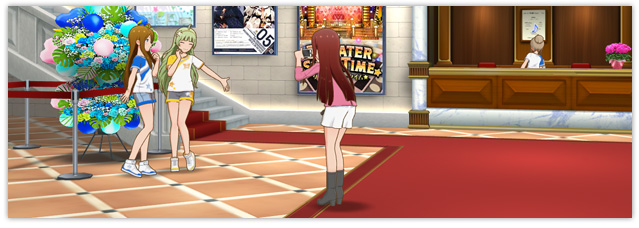
©BANDAI NAMCO Entertainment Inc.
●Higashi: There is a story in the Main Communication part, but its narrative is always the same: a certain girl is selected for the first time to take the center position on stage. As a result, it tends to use similar story arcs. We want to always provide the player with new experiences, so we’re constantly faced with the problem of how to keep the game interesting. Thinking about each girl’s personality and spinning the most intriguing story as possible out of it, identifying multiple plot points, and then connecting them to form a coherent story is never easy. But whenever we receive feedback, tough criticism, or are told that our story was moving, we always get the motivation to give our best for the next story.
■Komachi: And I hear you also pay attention to how close the player is with the idols when they interact?
●Higashi: We are especially mindful of how we word the producer’s (a.k.a. the player’s) dialogue options, and try to write them without interfering with their role as the voice of the player. These lines give you the chance to give gentle words of advice to the idols, lift up their spirits by poking fun at their cute antics, or to wrap up the end of a conversation with a turn of words that leaves the reader with a refreshing sense of closure. We sometimes spend entire days worrying about how to wrap up conversations, or how to phrase jokes. There’s an enormous amount of trial-and-error that goes into our work.
■Komachi: And you have to create dialogue that matches the personality of every single character in the game! Just thinking about it makes me woozy.
Devising Unique Personalities for Each Idol During Character Creation
●Tsuchihama: The cel shading (*3) used in MLTD has a different look than the past Imas console games. We spent a long time perfecting the visuals and programming to get the 3D rendered output looking just right.
*3: Cel shading
A method to make 3DCG look like traditional cel (2D) animation.
●Tamiya: We followed the same principle that we used when making console titles, which is to not simply adapt an anime look in the game, but to create a cel shaded anime style that takes advantage of 3D space. We worked with our engineers to pull off things that can’t easily be done in hand-drawn images, like expressing light and shadow, or looks that are tricky to pull off in smartphone games. I think we were ultimately able to create a style that communicates three-dimensionality and space.
●Ikeda: One of the big challenges for the engineering team was creating shaders. We did a lot of trial-and-error to figure out how to draw characters’ outlines, or how shadows should be cast. We even made a stray hair shader, so that strands of hair that stick out cast shadows that look good from every angle. When we made the multiple shaders for all the different parts of our character models, we had to figure out how to write their scripts as we worked, and ended up fighting with reducing rendering costs right up until the deadline.
■Komachi: I was surprised that smartphones can even play animation as gorgeous as this!
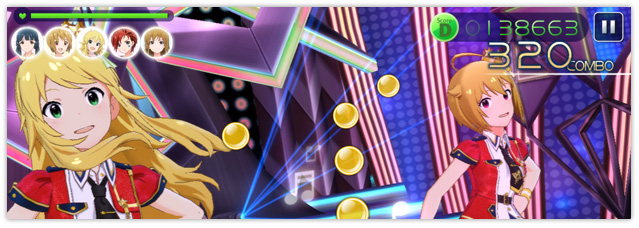
©BANDAI NAMCO Entertainment Inc.
●Tamiya: MLTD has fifty-three characters including the receptionist, Misaki-chan, and we had to create them all in 3D. But I think we were able to strike a good balance when we recreated the 2D illustrations on their cards.
We used the know-how we accumulated when making the console games to create their facial expressions and movements, and worked with the motion and scripting teams to avoid being overwhelmed with tasks for the multiple characters. I think we succeeded in giving each character their own personality.
■Komachi: And even the most subtle expressions were crafted with a lot of minute detail, like characters’ facial expressions when they put emotion into their singing during performances. Did you look back on the range of expressions you made during the years you spent working on console games, and use them to decide what sort of variations to put in this game?
●Tamiya: Each title we released on consoles had a larger number of expressions than the last. THE IDOLM@STER2 (*4) had twice as many as the first one. And all thirteen characters had their own assortment of custom expressions! (Laughs) The fifty-three characters in MLTD shared expressions to an extent, but we talked with the programmers to make sure that ones we felt were important were left in the game. This made it possible to create a diverse set of expressions that are on par with the console games.
*4: THE IDOLM@STER2
A console game released in 2011 by BANDAI NAMCO Entertainment:
http://bandainamcoent.co.jp/cs/list/idolmaster/im2/
●Kakizawa: The history that was created over the years we spent working on Imas is like a traditional craft that gets more refined as it’s passed down to newer generations.
●Tamiya: We borrowed tech from the console games, like the Costume System, which optimizes clothing to fit the idols’ various body types.
●Kakizawa: One of our big accomplishments in MLTD is giving all fifty-two idols different body types.
●Kubo: Even when idols with different heights get together, there’s a system to make the camera automatically correct to account for the difference, which made my work a lot easier. The awesome thing about the console team is that they prepared all of these systems based on their findings over the years. I really can’t thank them enough.

●Kiyotaka Tamiya
Designer/MLTD Art Director
●Tamiya: In MLTD we established a new highest card grade, SSR. We wanted these cards to be special, and decided their card art should use illustrations to give them a sense of originality.
I think we succeeded creating a rich, high-quality art style for their hair, eyes, and the ambience of the backgrounds. Our staff were especially meticulous in choosing poses and expressions that show each character’s personality.
■Komachi: Just looking at the card art and flavor text, you can feel how nervous a character gets while working, or discover another side to their everyday life. It really shows the depth behind each character and the amount of thought that was put into their world. I felt that there were many things that would never end up on paper without the quantity of documents and interviews that you accumulated over the years. Scenario documents included, you really feel this information amounts to something huge.
●Higashi: I think in character-centric media, the title’s allure is dependent on characters’ personalities, which we try to maintain as much as possible. We take great care in creating situations or lines that bring out as much of a character’s personality as possible. Even if you have the same character in the same situation, if you take a different approach, or slightly adjust the way you look at a scene, you see a completely different side of the character.
●Sato: Even when designing sound, we pay the most attention to characters’ personalities, and aim to be discerning in our work. We think not just about what sort of songs fit each character, but also how each character would phrase the vocals for each song, or what sort of things two characters would do if they were paired together. Just like scenario writers and visual artists, we try to imagine each character’s personality as we record songs.
But it’s not enough just to have the characters sing well. You have to be able to imagine the character singing on stage, full of life, through sound alone. We talk with a lot of different sections, starting with Higashi’s character design group, and even with the scenario writers and performance planners, and try to take a holistic approach to our work. I think that’s the enjoyment of working as a part of a larger group. We can accomplish many things that would be impossible with just sound alone, which makes our work a lot of fun.
■Komachi: All dialogue is voiced, and animators lip sync characters’ animations to the dialogue, which in all must be a huge amount of work!

●Takafumi Sato
Sound Designer Composer/MLTD Sound Director
●Sato: Sound designers work on recording songs, background music, and special effects, but we also spend a lot of time recording dialogue and vocals.
Part of what makes working on Imas fun is that, when recording, we work with the cast to build up each character. No character’s personality is set in stone, and there are no correct answers. We often talk with the cast about what direction to take certain characters, and talk about how to make them grow as characters. We never compromise with our ideas and are always on the lookout for things that make us think, “That idea also works here!” Or, “That’s an interesting side of the character we haven’t seen before!” It’s fun to discover new sides to the characters, and to make them mature as we work. It makes our job feel worth doing.
The Driving Force behind IDOLM@STER’s that Captures the Hearts of Even its Staff
■Komachi: Every day many people, including staff who weren’t able to talk today, pour so much passion into their work on MLTD. What do you think it is about Imas that creates this unifying force that allows so many people to pour their heart and soul into the project? Ever since I first saw staff making the game as part of their job, I wondered what about the project draws so much passion out of its staff.
●Higashi: Imas’ songwriter, (Koji) Nakagawa said in the past that “Imas is a curious project, because before staff realize it, they’re in love with it. It has a strange sort of gravity.” I feel the same way. I had never worked on a project where you get to see fans in person as close as in this one, which was also a surprise for me. I think just the desire to make them happy has kept me on the project this long.
●Sato: That’s a big source of motivation, isn’t it.
●Kubo: We get to hear more people output their thoughts and opinions much more often than a normal game, don’t we. Imas fans bring so much passion to the game by themselves. Just feeling the response from fans convinces me that Imas is the best game to work on.
●Higashi: The characters in Imas are depicted as girls whose personalities have a degree of realism to them, and the scenarios and game systems feel like they could actually exist. The player (a.k.a. producer) uses their imagination to decide what idols would accompany the character that’s going to be in the center position, which songs those characters would sing, and who takes which part. This gives the game a sense of reality. I’ve tried to stay faithful to that sense of reality ever since I joined the project, and I like to think that that may be one of the reasons so many people love the series.
●Kubo: I think the idea to use the word “producer” was a huge invention. We spent a long time meditating on our choice of words. Each player, each fan is a producer, and they are put in the position of creator or publisher, which means they help raise not just their idols, and also Imas as a whole.
●Higashi: And the same goes for everyone in the position of players, who are asked to help raise the story’s heroines: their idols.
●Sato: While we work as developers, we also enjoy the game as fans, which makes us want to make our idols and Imas as a series shine as bright as it can, and do as much for the game as we can!
●Tamiya: After I joined production and started working on the characters, I started to pick out my favorite characters. I started to want to make the characters I like the best they can be, since I’m also their producer. (Laughs) This helped me feel closer to all of our fans, and the series has only grown on me since then.
■Komachi: Creators end up as both producers and customers. That’s fascinating!
●Sato: This goes for both Kubo and myself, but both of us and many other members are very passionate about this project, which leads to a positive feedback loop, where one person will suggest something, and someone else will say, “That would be really tough to create, but I want to do it too, so let’s give it a shot!” After you release a game that was made in a positive environment, all of the producers that play the game can tell what went into it. We then see their reactions and want to give our best the next time. I feel like this creates a good cycle.
●Ikeda: I originally didn’t know a lot about Imas, and at first I wasn’t able to keep track of which character is which. But once I started to figure them out, I found characters that I thought are cute, or others that are hilarious and made me want to continue progressing through the game, and even started to want certain characters’ cards. I now enjoy the game the same way as its fans do as I work on it. When someone suggests an interesting new idea, the thrill we all get when we talk about is amazing. Even if we don’t have a lot of time, we’ll say, “Implementing it should only take about a day, so we should be able to work it out. Let’s give it a try!” Even when someone brings up a small idea, we talk about how it would make the game even better, or how fans would definitely respond positively, and then the whole team gets on board to implement it. It’s fun to watch over our work environment; there are a lot of surprises and excitement every day.
●Sato: This goes for the MLTD team, but everyone on the team really likes Imas. Everyone developing MLTD plays the game in their spare time just because they want to.
●Kakizawa: Even though they spend so much time playing it on development consoles, they still plug away at it on their own phones.
●Tsuchihama: I also feel very grateful to work on the Imas series. The project isn’t staffed just by people who were originally fans of the series, but also by people who didn’t play it at first. They start to like the series while they work on it, which makes them want to look proactively for ways improve the game. As creators, we’re very happy to be able to work in an environment where all of the members work together every day to come up with things to improve, or new directions to take the project.
■Komachi: The entire staff enjoys Imas, and their passion for the series means they can continue to output great games. What an amazing development team!
I have high expectations for MLTD’s future! Thank you, everyone for talking today!
THE IDOLM@STER
Product of BANDAI NAMCO Entertainment Inc.
©Toshiyuki Kubooka ©BANDAI NAMCO Entertainment Inc.
THE IDOLM@STER MILLION LIVE! THEATER DAYS
Produce the idol group 765 Million All Stars in the 765 Pro Live Theater! Be it during performances on stage, at work, or by communication in the theater, the game is packed with chances to interact with idols!
Official site
https://millionlive.idolmaster.jp/theaterdays/
Distributer:BANDAI NAMCO Entertainment Inc.
ⒸToshiyuki Kubooka ⒸBANDAI NAMCO Entertainment Inc.




